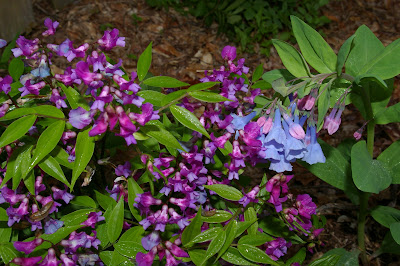 | |||
| Two of my favorite shady characters |
The Daily DuBrule
Today I gave a talk to a wonderful garden club in West Hartford about succession of bloom with native plants. True to form, I went on a bit too long since I had SO much to share. Topping my all time favorites for shade is Mertensia virginica, Virginia bluebells. I think I like this so much because it was the first native wildflower I had success with. I planted a few bits of bare root pieces in the Natureworks gardens back in 1990. Today, I have one entire bed filled with this blue beauty in early May. The ground below is carpeted with blue Scilla and Chionodoxa bulbs that have naturalized equally well. Because this plant goes dormant in the early summer, along with the bulbs, this can be a problem. I solved this by allowing my favorite bee balm, Monarda 'Mahogony' to spread where the Virginia bluebells live. The deep maroon flowers and long lasting, colorful bracts of this excellent cultivar marry with a 'Royal Occasion' deep red daylily and a Weigela 'Wine and Roses' nearby. Yes, I have to occasionally tame the bee balm, but it is worth it for all the hummingbird action it brings me.
Paired with the Mertensia above is a shade plant that many people don't know about. It is not native, but it fares very well in DRY SHADE, a situation that can be quite challenging. It is Lathyrus vernus, also called spring vetchling. I blooms in April into early May with bright purple/magenta flowers that fade to a glowing blue color. Because it is a legume, it seems to tolerate dryness well. The foliage does not go dormant in the summer. The seed pods look like little, upright, twisted pea pods. If left on the plant, they will drop their seeds and babies will appear throughout the bed, always a welcome treat.
When you love early spring wildflowers that later disappear on you, it is vital that you cover the holes they leave with something that sustains. Ferns are an obvious choice to fill in after Virginia bluebells as they sprout much later in the spring and quickly catch up as the Mertensia is beginning to fade. Always know what your plants do after blooming- that is the secret to an attractive garden every month of the growing season.
Nancy! It was so great to see you today! My post was about you and your wonderful talk. I hope you like it! http://natural-elegance.blogspot.com/
ReplyDeleteJulie, What a sweet surprise to find out that that beautiful baby that was so enjoying my talk was yours! I loved seeing you and wish you lots of luck with your new design business. I LOVE your garden club, they are serious about gardening and so gracious. Nancy
Delete